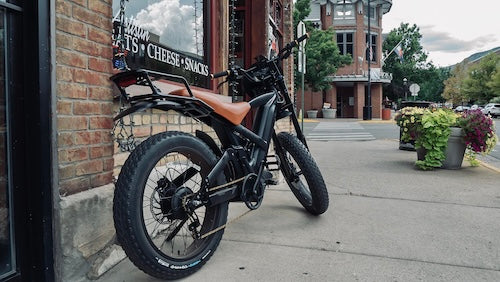Everything You Need to Know About Ebikes

In recent years, ebikes have become increasingly popular as a mode of transportation and a recreational activity. But what exactly are ebikes and why are they gaining so much attention?
If you're new to the world of ebikes, you probably have a lot of questions. Don't worry, we've got you covered.
In this comprehensive guide, we'll answer all your burning questions about ebikes, from what they are and how they work to regulations and safety concerns.
So sit back, relax, and get ready to learn everything you need to know about ebikes.
What is an ebike?

Ebikes, also known as electric bicycles, are a form of transportation that combine the benefits of traditional bicycles with electric motors. These motors assist with pedaling, providing an extra boost of power that can make cycling easier and more enjoyable. Unlike motorcycles or mopeds, ebikes still require pedaling to operate, with the motor providing supplemental assistance.
Ebikes come in various designs, from everyday city ebikes to rugged off rod electric bikes. They typically have a rechargeable battery that powers the electric motor, which can be activated either through a throttle or by pedaling. The amount of assistance provided by the motor can often be adjusted, allowing riders to customize the level of support they receive.
One of the major advantages of ebikes is their versatility. They can be used for commuting, off roading, hunting, security and military duties, or simply enjoying a leisurely ride on your favorite route.
When it comes to purchasing an ebike, there are many options to choose from. You can find a variety of styles and models, ranging from affordable entry-level options to high-end performance ebikes. Some popular categories include all terrain ebikes, hunting ebikes, and cafe racer ebikes.
Safety and Licensing Requirements for an Ebike
When it comes to safety, ebikes are a great option for those who want to enjoy the benefits of cycling without exerting too much physical effort that could lead to injury. However, it's important to be aware of the safety and licensing requirements associated with owning and riding an ebike.
In terms of safety, it's essential to wear a helmet while riding an ebike, just as you would with a traditional bicycle. Helmets help protect your head in the event of a fall or collision, reducing the risk of serious injury. Additionally, it's important to follow all traffic laws and regulations when riding an ebike. This means obeying traffic signals, using hand signals to indicate your turns, and riding in the designated lanes or paths.
When it comes to licensing, the requirements for ebikes vary depending on where you live. In many areas, ebikes that have a top speed of 20 mph or less and a motor that produces 750 watts or less are classified as bicycles and do not require a special license or registration.
However, it's important to check the specific regulations in your area, as they may differ..
How fast does an ebike go?

When it comes to ebikes, one of the burning questions many people have is, "How fast do they go?" Well, the answer can vary depending on the model and the regulations in your area.
In general, class 1 ebikes have a top speed of around 20 mph (32 km/h). This speed is regulated to ensure the safety of riders and pedestrians. However, it's important to note that some high-performance class 2 and 3 ebikes can reach speeds of up to 28 mph (45 km/h) or even higher.
The speed at which an ebike can go is determined by several factors, including the power of the motor and the weight of the rider. Higher wattage motors and lighter riders can typically achieve faster speeds. Additionally, the terrain and riding conditions can also impact the speed of an ebike. Riding uphill or on rough terrain may cause the motor to work harder and decrease the overall speed.
It's also worth mentioning that the speed of an ebike can be adjusted. Many models come with multiple assistance levels, allowing riders to choose how much help they want from the motor. For example, you may have an "eco" mode that provides a gentle boost or a "sport" mode that delivers maximum power.
QuietKat Electric Bikes have a new technology called VPO™ which stands for Variable Power Output. With all-new Variable Power Output (VPO™) Technology, you can select between classifications and power output levels to stay in compliance wherever you ride.
If you're looking to for an ebike for sale, it's important to consider your intended use and the local regulations. Some areas may have specific speed limits for ebikes, so be sure to check the rules and regulations in your area.
Overall, ebikes offer a great balance between speed and convenience. Whether you're commuting to work or enjoying a leisurely ride, an ebike can provide an efficient and enjoyable way to get around. So, if you're in the market for an ebike, start exploring the best ebikes or check for ebikes for sale or ebikes near me to find the perfect fit for your needs and start enjoying the ride.
An Overview of Ebike Regulations in the U.S.
When it comes to riding an ebike in the United States, it's important to be aware of the regulations that govern their use. Each state has its own specific laws regarding ebikes, so it's crucial to familiarize yourself with the regulations in your area before hitting the road.
Most states classify ebikes as bicycles as long as they meet certain criteria. These criteria typically include a maximum top speed of 20 mph and a motor power of 750 watts or less. As long as your ebike falls within these limits, you generally won't need a special license or registration to ride it.
However, it's important to note that some states have additional requirements. For example, certain states may require riders to be a certain age, such as 16 or 18, in order to operate an ebike. Other states may have specific rules regarding where ebikes are allowed to be ridden, such as on bike paths or designated lanes.
In addition to state regulations, it's also important to be aware of any local laws that may apply. Some cities or municipalities may have their own regulations that differ from state laws. For example, certain areas may have lower speed limits for ebikes or require additional safety equipment such as lights or reflectors.
It's important to research the regulations in your specific area to ensure that you're in compliance with the law. This will help ensure your safety and the safety of others while enjoying your ebike. Remember, it's always better to be informed and prepared before hitting the road.
Take the time to familiarize yourself with the regulations in your area. By doing so, you can ride confidently and enjoy all the benefits that ebikes have to offer.
The Mechanics of the Ebike: How does it Work?
The mechanics of an ebike may seem complex at first, but understanding how they work is crucial to getting the most out of your ride. So, let's dive into the nitty-gritty of how these amazing machines operate.
At the heart of an ebike is its electric motor, which provides the extra power that sets it apart from a traditional bicycle. The motor is powered by a rechargeable battery that is typically mounted on the frame of the bike. This battery supplies the energy needed to propel the motor and assist with pedaling.
When you start pedaling, sensors on the ebike detect the motion and activate the motor. The motor then kicks in, providing additional power to the pedals, making pedaling easier and helping you overcome challenging terrain or steep hills. The amount of assistance the motor provides can usually be adjusted using a control panel on the handlebars, allowing you to choose the level of support that suits your riding style and conditions.
The battery life of an ebike can vary depending on factors such as the power of the motor, the terrain you're riding on, and how much you rely on the motor for assistance. Most ebikes have a range of around 20-60 miles per charge, but this can vary greatly depending on the specific model and riding conditions.
To recharge the battery, simply plug it into a standard electrical outlet using the charger that comes with your ebike. The time it takes to fully recharge the battery can vary, but it usually takes anywhere from 3 to 6 hours.
Overall, understanding the mechanics of an ebike can help you make informed decisions about your riding experience. So, now that you know how ebikes work, you can confidently hit the road and enjoy all the benefits they have to offer.
Top Factors to Consider When Purchasing an Ebike
When it comes to purchasing an ebike, there are several factors to consider that can help you make the right choice. Let's explore some of the top factors that you should keep in mind before making your purchase.
- Budget: One of the first things to consider is how much you are willing to spend on an ebike. The price range for ebikes can vary greatly, depending on factors such as brand, quality, and features. Determine your budget and look for options that fall within your price range.
- Purpose: Consider the purpose for which you will be using the ebike. Are you planning to use it for commuting, recreational riding, or off-road adventures? Different ebike models are designed for specific purposes, so it's important to choose one that suits your intended use.
- Motor Power: The power of the motor is another important factor to consider. The power of an ebike's motor is measured in watts, and a higher wattage motor generally provides more assistance and better performance. Consider your needs and preferences when it comes to motor power.
- Battery Range: The range of an ebike refers to how far it can travel on a single charge. If you plan to use your ebike for long rides or commuting, you'll want to choose a model with a longer battery range. Consider your typical riding distance and choose a battery range that suits your needs.
- Bike Frame and Design: The frame and design of the ebike can impact your riding experience and comfort. Consider factors such as frame material, frame size, and the overall design of the bike. Make sure to choose a frame and design that suits your body type and riding style.
- Customer Reviews: Before making a purchase, it's a good idea to read customer reviews and feedback about the ebike you are considering. This can give you valuable insights into the performance, reliability, and overall satisfaction of previous buyers.
- Warranty and After-Sales Support: Finally, consider the warranty and after-sales support offered by the manufacturer. A good warranty and reliable after-sales support can give you peace of mind and ensure that any issues or concerns you may have with your ebike are addressed promptly.
By considering these top factors, you can make an informed decision and find an ebike that meets your needs and preferences. So, take your time, do your research, and choose an ebike that will provide you with years of enjoyment and reliable performance.




 USA
USA Canada
Canada




